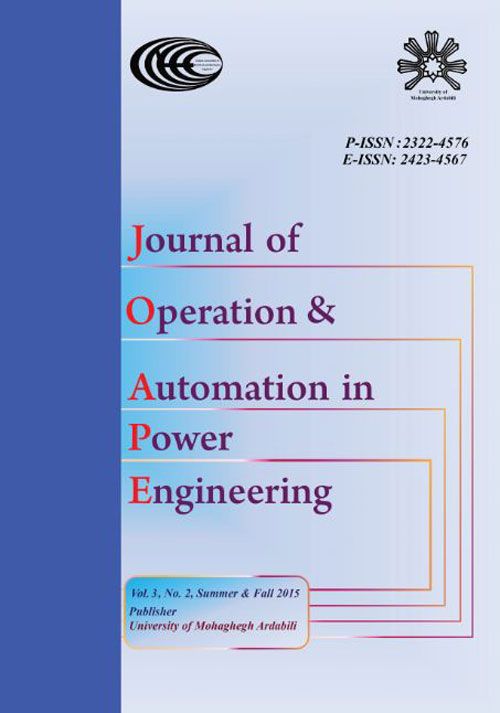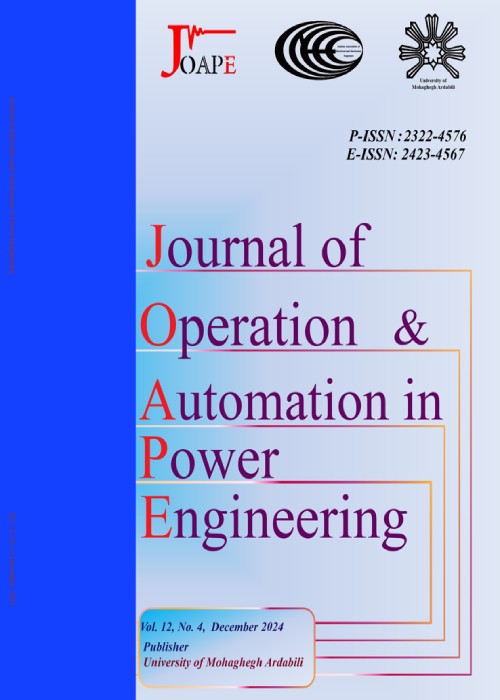فهرست مطالب

Journal of Operation and Automation in Power Engineering
Volume:3 Issue: 2, Summer - Autumn 2015
- تاریخ انتشار: 1394/11/11
- تعداد عناوین: 7
-
-
Pages 94-101This paper presents a method for diagnosis of eccentricity fault in a switched-reluctance motor (SRM) during offline and standstill modes. In this method, the fault signature is differential induced voltage (DIV) achieved by injecting diagnostic pulses to the motor windings. It will be demonstrated by means of results that there is a correlation between differential induced voltage and eccentricity occurrence. The method employs three-dimensional transient finite-element method (TFEM) analysis to calculate differential induced voltage in three phase 6/4 SRM. In this method, first of all the fault presence is distinguished. Next, an algorithm is presented for the detection of fault location or faulty phase. Then, the direction of fault is recognized by a simple comparative technique, and finally, results comparing is proposed to detect fault type.Keywords: Eccentricity fault, Differential induced voltage, Transient finite, element method
-
Pages 102-115This paper proposes an Optimal Power Flow (OPF) algorithm by Direct Load Control (DLC) programs to optimize the operational cost of smart grids considering various scenarios based on different constraints. The cost function includes active power production cost of available power sources and a novel flexible load curtailment cost associated with DLC programs. The load curtailment cost is based on a virtual generator for each load (which participates in DLC program). To implement the load curtailment in the objective function, we consider incentive payments for participants and a load shedding priority list in some events. The proposed OPF methodology is applied to IEEE 14, 30-bus, and 13-node industrial power systems as three examples of the smart grids, respectively. The numerical results of the proposed algorithm are compared with the results obtained by applying MATPOWER to the nominal case by using the DLC programs. It is shown that the suggested approach converges to a better quality solution in an acceptable computation time.Keywords: Automated demand response, Demand response, Direct load control, Load curtailment, Optimal power flow, Smart grid
-
Pages 116-130This paper presents a novel concept of "smart distribution system expansion planning (SDEP)" which expands the concept of demand response programs to be dealt with the long term horizon time. The proposed framework, integrates demand response resources (DRRs) as virtual distributed generation (VDG) resources into the distribution expansion planning. The main aim of this paper is to develop and initial test of the proposed model of SDEP to include DRRs which are one of the most important components to construct smart grid. SDEP is modeled mathematically as an optimization problem and solved using particle swarm optimization algorithm. The objective function of the optimization problem is to minimize the total cost of lines’ installation, maintenance, demand response persuasion, energy losses as well as reliability. Furthermore, the problem is subject to the constraints including radiality and connectivity of the distribution system, permissible voltage levels, the capacity of lines, and the maximum penetration level of demand response. Based on two sample test systems, the simulation results confirmed that the consideration of DRRs simultaneously with distribution system expansion can have economical profit for distribution planners.Keywords: Demand response resources, Distribution expansion planning, Smart grid
-
Pages 131-146In this paper, simultaneous placement of distributed generation, capacitor bank and protective devices are utilized to improve the efficiency of the distribution network. The objectives of the problem are reduction of active and reactive power losses, improvement of voltage profile and reliability indices and increasing distribution companies’ profit. The combination of firefly algorithm, particle swarm optimization and analytical hierarchy process is proposed to solve the multi-objective allocation problem. The proposed method is implemented on IEEE 69-bus and also an actual 22-bus distribution systems in Tehran-Iran. Test results approve the effectiveness of the proposed method for improved reliability and network performance of the distribution network.Keywords: Analytical hierarchy process, Capacitor banks, Distributed generation, Hybrid firefly algorithm, particle swarm optimization, Multi, objective optimization, Protective device
-
Pages 147-157Flashover of polluted insulators in contaminated areas is one of the most important factors influencing the operation of transmission and distribution lines and finally line outages. Therefore, it is essential to prevent and detect flashover in the insulators. Hence, utilizing the insulator status monitoring systems and predicting their functions have absorbed a lot of attention over the recent years. In this paper, a new method is proposed for flashover prediction in porcelain and glass insulators. In this regard, a variety of experiments has been conducted on different types of insulators under different environmental conditions and analysis of their leakage current harmonics have been investigated. Fast Fourier Transform (FFT) analysis applied to the saved leakage current waveforms shows a strong correlation between the ratio of the third to fifth harmonic amplitudes by regarding the occurrence of critical conditions and degree of insulator ageing. Then, the third to fifth harmonic ratio of the leakage current (R3/5) has been proposed as an indicator of critical conditions in porcelain and glass insulators. The results of these experiments show that the mentioned harmonic ratio has a definite and constant procedure against the changes in the type of pollution and humidity rate. The results of experiments have indicated that increasing the index R3/5 to more than one represents a critical condition in the insulators and estimates a high probability of flashover. Also in whole the tests, value of the total harmonic distortion (THD) and flashover voltage are measured.Keywords: Insulators, Pollution, Leakage current, Flashover, Harmonic
-
High performance Cuk converter considering non-linear inductors for photovoltaic system applicationsPages 158-166The Cúk converter, which has voltage buck and boost ability, offers high flexibility as an interface device for solar panels. In addition, current ripple can be more reduced because of two input and output inductors at both sides. This paper presents a new application of current-variable inductors in a Cúk converter that reduces the size and capacity of storage elements. Because of two inductors in structure, implementation of these variable inductors is important; therefore, the proposed design leads to cost and size savings, increases the performance interval of tracker to gain solar energy at lower sunlight levels, and simplifies control strategy. To validate the effectiveness of this structure, the analytical analysis, simulation results using PSCAD/EMTDC software and experimental results are presented.Keywords: Variable inductor, Photovoltaic, Obtaining maximum power, Impedance match, Cúk converter
-
Pages 167-184In this paper, a new topology for boost Z-source inverterbased on switched-inductor cell is proposed. The operating modes of the proposed inverter are analyzed and also a suitable control method to generate the trigger signals of the inverter is presented. Having a common earth between the input source and inverter and capability to generate a higher voltage gain by using lower amounts of the duty cycles are some advantages of the proposed Z-source inverter. Comparison of the proposed inverter with conventional Z-source inverters is presented from different points of the view. Finally, the accuracy performance of the proposed inverter is reconfirmed through the simulation results in EMTDC/PSCAD software program.Keywords: Z, source inverter, Shoot, through, Switched boost inverter, Switched, inductor cell


